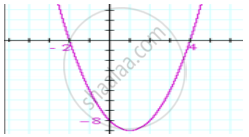Advertisements
Advertisements
Question
If α, β are the zeros of the polynomial f(x) = x2 − p(x + 1) − c such that (α +1) (β + 1) = 0, then c =
Options
1
0
-1
2
Solution
Since `alpha` and `beta` are the zeros of quadratic polynomial
f(x) = x2 − p(x + 1) − c
`f(x)= x^2 - px -p-c`
`alpha + ß = - (text{coefficient of x})/(text{coefficient of } x^2)`
`= -(-p/1)`
`= p`
`alphabeta= (\text{Coefficient of x})/(\text{Coefficient of}x^2)`
`= (-p-c)/1`
`= -p-c`
We have
`0 = (alpha + 1)(beta+1)`
`0=alpha beta + (alpha +beta)+1`
`0 = - cancel(p)-c + cancel(p) +1`
`0 = -c +1`
The value of c is 1.
Hence, the correct alternative is `(a)`
APPEARS IN
RELATED QUESTIONS
A plane left 30 minutes late than its scheduled time and in order to reach the destination 1500 km away in time, it had to increase its speed by 100 km/h from the usual speed. Find its usual speed.
Write the standard form of a cubic polynomial with real coefficients.
If a − b, a and b are zeros of the polynomial f(x) = 2x3 − 6x2 + 5x − 7, write the value of a.
If α, β are the zeros of a polynomial such that α + β = −6 and αβ = −4, then write the polynomial.
If α, β are the zeros of the polynomial 2y2 + 7y + 5, write the value of α + β + αβ.
If graph of quadratic polynomial ax2 + bx + c cuts positive direction of y-axis, then what is the sign of c?
Figure 2.23 show the graph of the polynomial f(x) = ax2 + bx + c for which

State whether the given algebraic expression is polynomial? Justify.
10
Which of the following is not the graph of quadratic polynomial?
An asana is a body posture, originally and still a general term for a sitting meditation pose, and later extended in hatha yoga and modern yoga as exercise, to any type of pose or position, adding reclining, standing, inverted, twisting, and balancing poses. In the figure, one can observe that poses can be related to representation of quadratic polynomial.


The two zeroes in the below shown graph are:

